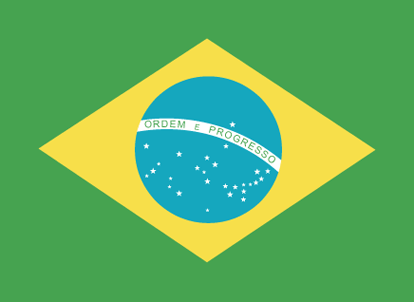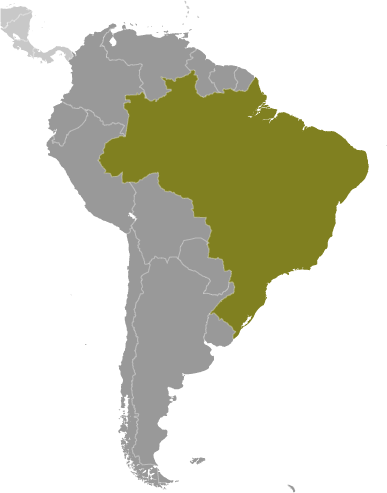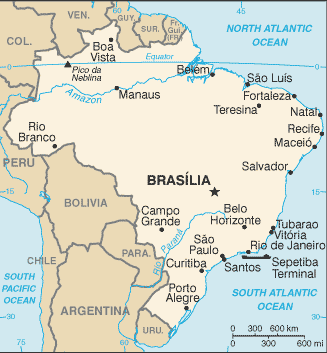|
Country name:
|

|
|
conventional long form: Federative Republic of Brazil
conventional short form:
Brazil
local long form:
Republica Federativa do Brasil
local short form:
Brasil
|
|
|
Government type:
|

|
|
federal republic
|
|
|
Capital:
|

|
|
name: Brasilia
geographic coordinates:
15 47 S, 47 55 W
time difference:
UTC-3 (2 hours ahead of Washington, DC during Standard Time)
daylight saving time:
+1hr, begins third Sunday in October; ends third Sunday in February
note:
Brazil is divided into three time zones, including one for the Fernando de Noronha Islands
|
|
|
Administrative divisions:
|

|
|
26 states (estados, singular - estado) and 1 federal district* (distrito federal); Acre, Alagoas, Amapa, Amazonas, Bahia, Ceara, Distrito Federal*, Espirito Santo, Goias, Maranhao, Mato Grosso, Mato Grosso do Sul, Minas Gerais, Para, Paraiba, Parana, Pernambuco, Piaui, Rio de Janeiro, Rio Grande do Norte, Rio Grande do Sul, Rondonia, Roraima, Santa Catarina, Sao Paulo, Sergipe, Tocantins
|
|
|
Independence:
|

|
|
7 September 1822 (from Portugal)
|
|
|
National holiday:
|

|
|
Independence Day, 7 September (1822)
|
|
|
Constitution:
|

|
|
5 October 1988
|
|
|
Legal system:
|

|
|
civil law; note - a new civil law code was enacted in 2002 replacing the 1916 code
|
|
|
International law organization participation:
|

|
|
has not submitted an ICJ jurisdiction declaration; accepts ICCt jurisdiction
|
|
|
Suffrage:
|

|
|
voluntary between 16 to under 18 years of age and over 70; compulsory 18 to 70 years of age; note - military conscripts do not vote by law
|
|
|
Executive branch:
|

|
|
chief of state: President Dilma ROUSSEFF (since 1 January 2011); Vice President Michel TEMER (since 1 January 2011); note - the president is both the chief of state and head of government
head of government:
President Dilma ROUSSEFF (since 1 January 2011); Vice President Michel TEMER (since 1 January 2011)
cabinet:
Cabinet appointed by the president
(For more information visit the World Leaders website  ) )
elections:
president and vice president elected on the same ticket by popular vote for a single four-year term; election last held on 3 October 2010 with runoff on 31 October 2010 (next to be held on 5 October 2014 and, if necessary, a runoff election on 2 November 2014)
election results:
Dilma ROUSSEFF (PT) elected president in a runoff election; percent of vote - Dilma ROUSSEFF 56.01%, Jose SERRA (PSDB) 43.99%
|
|
|
Legislative branch:
|

|
|
bicameral National Congress or Congresso Nacional consists of the Federal Senate or Senado Federal (81 seats; 3 members from each state and federal district elected according to the principle of majority to serve eight-year terms; one-third and two-thirds of members elected every four years, alternately) and the Chamber of Deputies or Camara dos Deputados (513 seats; members are elected by proportional representation to serve four-year terms)
elections:
Federal Senate - last held on 3 October 2010 for two-thirds of the Senate (next to be held in October 2014 for one-third of the Senate); Chamber of Deputies - last held on 3 October 2010 (next to be held in October 2014)
election results:
Federal Senate - percent of vote by party - NA; seats by party - PMDB 20, PT 13, PSDB 10, DEM (formerly PFL) 7, PTdoB 6, PP 5, PDT 4, PR 4, PSB 4, PPS 1, PRB 1, other 3; Chamber of Deputies - percent of vote by party - NA; seats by party - PT 87, PMDB 80, PSDB 53, DEM (formerly PFL) 43, PP 41, PR 41, PSB 34, PDT 28, PTdoB 21, PSC 17, PCdoB 15, PV 15, PPS 12, other 26
|
|
|
Judicial branch:
|

|
|
Supreme Federal Tribunal or STF (11 ministers are appointed for life by the president and confirmed by the Senate); Superior Tribunal of Justice or STJ; Superior Electoral Tribunal or TSE; Regional Federal Tribunals (judges are appointed for life); note - though appointed "for life," judges, like all federal employees, have a mandatory retirement age of 70
|
|
|
Political parties and leaders:
|

|
|
Brazilian Communist Party or PCB [Ivan Martins PINHEIRO]; Brazilian Democratic Movement Party or PMDB [Valdir RAUPP, acting]; Brazilian Labor Party or PTB [Benito GAMA, acting]; Brazilian Renewal Labor Party or PRTB [Jose Levy FIDELIX da Cruz]; Brazilian Republican Party or PRB [Marcos Antonio PEREIRA]; Brazilian Social Democracy Party or PSDB [Sergio GUERRA]; Brazilian Socialist Party or PSB [Eduardo CAMPOS]; Christian Labor Party or PTC [Daniel TOURINHO]; Christian Social Democratic Party or PSDC [Jose Maria EYMAEL]; Communist Party of Brazil or PCdoB [Jose Renato RABELO]; Democratic Labor Party or PDT [Carlos Roberto LUPI]; the Democrats or DEM [Jose AGRIPINO] (formerly Liberal Front Party or PFL); Free Homeland Party or PPL [Sergio Rubens de Araujo TORRES]; Freedom and Socialism Party or PSOL [Ivan VALENTE]; Green Party or PV [Jose Luiz PENNA]; Humanist Party of Solidarity or PHS [Eduardo Machado e Silva RODRIGUES]; Labor Party of Brazil or PTdoB [Luis Henrique de Oliveira RESENDE]; National Ecologic Party or PEN [Adilson Barroso OLIVEIRA]; National Labor Party or PTN [Jose Masci de ABREU]; National Mobilization Party or PMN [Oscar Noronha FILHO]; Party of the Republic or PR [Alfredo NASCIMENTO]; Popular Socialist Party or PPS [Roberto Joao PEREIRA FREIRE]; Progressive Party or PP [Francisco DORNELLES]; Progressive Republican Party or PRP [Ovasco Roma Altimari RESENDE]; Social Christian Party or PSC [Vitor Jorge Abdala NOSSEIS]; Social Democracy Party or PSD [Gilberto KASSAB]; Social Liberal Party or PSL [Luciano Caldas BIVAR]; United Socialist Workers'Party or PSTU [Jose Maria DE ALMEIDA]; Workers'Cause Party or PCO [Rui Costa PIMENTA]; Workers' Party or PT [Rui FALCAO]
|
|
|
Political pressure groups and leaders:
|

|
|
Landless Workers' Movement or MST
other:
industrial federations; labor unions and federations; large farmers' associations; religious groups including evangelical Christian churches and the Catholic Church
|
|
|
International organization participation:
|

|
|
AfDB (nonregional member), BIS, BRICS, CAN (associate), CD, CELAC, CPLP, FAO, FATF, G-15, G-20, G-24, G-77, IADB, IAEA, IBRD, ICAO, ICC (national committees), ICRM, IDA, IFAD, IFC, IFRCS, IHO, ILO, IMF, IMO, IMSO, Interpol, IOC, IOM, IPU, ISO, ITSO, ITU, ITUC (NGOs), LAES, LAIA, LAS (observer), Mercosur, MIGA, MINURSO, MINUSTAH, NAM (observer), NSG, OAS, OECD (Enhanced Engagement, OPANAL, OPCW, Paris Club (associate), PCA, SICA (observer), UN, UNASUR, UNCTAD, UNESCO, UNFICYP, UNHCR, UNIDO, UNIFIL, Union Latina, UNISFA, UNITAR, UNMIL, UNMISS, UNMIT, UNOCI, UNWTO, UPU, WCO, WFTU (NGOs), WHO, WIPO, WMO, WTO
|
|
|
Diplomatic representation in the US:
|

|
|
chief of mission: Ambassador Mauro Luiz Iecker VIEIRA
chancery:
3006 Massachusetts Avenue NW, Washington, DC 20008
telephone:
[1] (202) 238-2805
FAX:
[1] (202) 238-2827
consulate(s) general:
Atlanta, Boston, Chicago, Hartford (CT), Houston, Los Angeles, Miami, New York, San Francisco
|
|
|
Diplomatic representation from the US:
|

|
|
chief of mission: Ambassador Thomas A. SHANNON
embassy:
Avenida das Nacoes, Quadra 801, Lote 3, Distrito Federal Cep 70403-900, Brasilia
mailing address:
Unit 7500, DPO, AA 34030
telephone:
[55] (61) 3312-7000
FAX:
[55] (61) 3225-9136
consulate(s) general:
Rio de Janeiro, Sao Paulo
consulate(s):
Recife
|
|
|
Flag description:
|

|
|
green with a large yellow diamond in the center bearing a blue celestial globe with 27 white five-pointed stars; the globe has a white equatorial band with the motto ORDEM E PROGRESSO (Order and Progress); the current flag was inspired by the banner of the former Empire of Brazil (1822-1889); on the imperial flag, the green represented the House of Braganza of Pedro I, the first Emperor of Brazil, while the yellow stood for the Habsburg Family of his wife; on the modern flag the green represents the forests of the country and the yellow rhombus its mineral wealth; the blue circle and stars, which replaced the coat of arms of the original flag, depict the sky over Rio de Janeiro on the morning of 15 November 1889 - the day the Republic of Brazil was declared; the number of stars has changed with the creation of new states and has risen from an original 21 to the current 27 (one for each state and the Federal District)
|
|
|
National symbol(s):
|

|
|
Southern Cross constellation
|
|
|
National anthem:
|

|
|
name: "Hino Nacional Brasileiro" (Brazilian National Anthem)
lyrics/music:
Joaquim Osorio Duque ESTRADA/Francisco Manoel DA SILVA
note:
music adopted 1890, lyrics adopted 1922; the anthem's music, composed in 1822, was used unofficially for many years before it was adopted
|
|
|
|
|





 )
)



